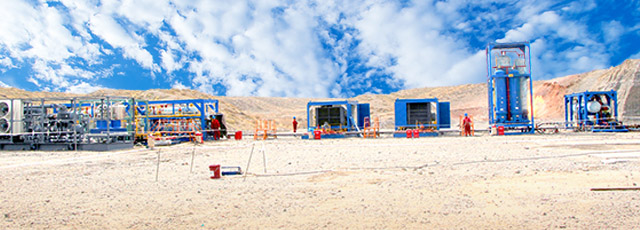1.Sulfur Recovery Unit
The sulfur recovery unit is a supporting environmental protection project for the desulfurization unit, which mainly converts the acid gas removed by the desulfurization unit into sulfur. The tail gas is then incinerated in the acid gas incineration unit and is being discharge into the atmosphere through the chimney.
The core unit (reaction unit) is a series of continuous production, and the auxiliary unit (sulfur forming unit) is intermittent production.
The main production units include: sulfur recovery unit, sulfur molding and packaging, and sulfur warehouse.
l The sulfur recovery unit of the first purification plant has a processing capacity of 10-27×104m3/d of acid gas, of which the H2S content is 1.3-3.4% (mol).
l The sulfur recovery unit of the second purification plant has a processing capacity of 12-30×104m3/d of acid gas, of which the H2S content is 1.55-3.59% (mol).
l Both units adopt the Clinsulf-DO direct oxidation process of Linde Company, Germany.

2.Brief Description of Sulfur Recovery Process
The acid gas from the air and desulfurization unit is preheated to 200 ℃ by medium pressure steam according to a certain proportion (the amount of air in the ideal proportion is calculated by one molecule of O2 and 1/2, and the proportion of air and H2S is generally 0.42). After entering the reactor, the hydrogen sulfide and oxygen in the acid gas undergo an exothermic reaction under the action of the catalyst to generate elemental sulfur. The normal temperature of the reactor is 292.1 ℃ (this temperature changes with the change of H2S content, and the control basis is shown in the table below). After the sulfur vapor from the reactor passes through the sulfur condenser and sulfur separator, the liquid sulfur enters the liquid sulfur storage tank, and then the liquid sulfur is transported to the sulfur solidification condenser by the liquid sulfur pump, and evenly drips onto the rotating steel belt through the distributor. Under the action of cooling water, the liquid sulfur solidifies on the steel belt into hemispherical particles, which are collected in the packaging hopper, and the tail gas is then incinerated before being discharge.

3.Acid Gas Incineration
The acid gas incineration unit is mainly used to incinerate the acid gas removed by the desulfurization unit, oxidize the acid gas H2S into SO2, and then discharge it into the environment. After the sulfur recovery unit is completed, this unit mainly deals with the tail gas generated by the sulfur recovery unit.
The acid gas removed by the desulfurization unit enters the sulfur recovery unit for processing, and the resulting tail gas enters the unit and is incinerated in the negative pressure incinerator (H-2101), so that H2S and sulfur in the tail gas are oxidized into SO2 and then discharged into the atmosphere. The high-temperature flue gas from the incinerator enters the chimney and is discharged.
In order to ensure safety, flame arresters are installed in the acid gas inlet and fuel gas inlet pipes. During normal operation, the furnace temperature should be controlled at about 600 ℃, and the furnace temperature and fuel gas pressure should be controlled in cascade. The purpose of controlling the furnace temperature is achieved by adjusting the fuel pressure.





